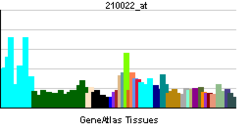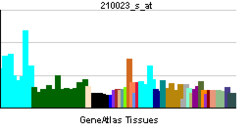- PCGF1
-
Polycomb group ring finger 1 Identifiers Symbols PCGF1; 2010002K04Rik; FLJ43754; MGC10882; NSPC1; RNF3A-2; RNF68 External IDs OMIM: 610231 MGI: 1917087 HomoloGene: 13090 GeneCards: PCGF1 Gene Gene Ontology Molecular function • protein C-terminus binding
• zinc ion binding
• metal ion bindingCellular component • nucleus
• nucleolus
• PcG protein complexBiological process • regulation of transcription, DNA-dependent
• histone H2A monoubiquitinationSources: Amigo / QuickGO RNA expression pattern 

More reference expression data Orthologs Species Human Mouse Entrez 84759 69837 Ensembl ENSG00000115289 ENSMUSG00000069678 UniProt Q9BSM1 n/a RefSeq (mRNA) NM_032673 NM_197992.1 RefSeq (protein) NP_116062 NP_932109.1 Location (UCSC) Chr 2:
74.73 – 74.74 MbChr 6:
83.03 – 83.03 MbPubMed search [1] [2] Polycomb group RING finger protein 1 is a protein that in humans is encoded by the PCGF1 gene.[1][2]
References
- ^ Nunes M, Blanc I, Maes J, Fellous M, Robert B, McElreavey K (Apr 2001). "NSPc1, a novel mammalian Polycomb gene, is expressed in neural crest-derived structures of the peripheral nervous system". Mech Dev 102 (1–2): 219–22. doi:10.1016/S0925-4773(01)00288-X. PMID 11287196.
- ^ "Entrez Gene: PCGF1 polycomb group ring finger 1". http://www.ncbi.nlm.nih.gov/sites/entrez?Db=gene&Cmd=ShowDetailView&TermToSearch=84759.
Further reading
- Valk-Lingbeek ME, Bruggeman SW, van Lohuizen M (2004). "Stem cells and cancer; the polycomb connection". Cell 118 (4): 409–18. doi:10.1016/j.cell.2004.08.005. PMID 15315754.
- Gong Y, Yue J, Wu X, et al. (2007). "NSPc1 is a cell growth regulator that acts as a transcriptional repressor of p21Waf1/Cip1 via the RARE element". Nucleic Acids Res. 34 (21): 6158–69. doi:10.1093/nar/gkl834. PMC 1693893. PMID 17088287. http://www.pubmedcentral.nih.gov/articlerender.fcgi?tool=pmcentrez&artid=1693893.
- Gearhart MD, Corcoran CM, Wamstad JA, Bardwell VJ (2006). "Polycomb Group and SCF Ubiquitin Ligases Are Found in a Novel BCOR Complex That Is Recruited to BCL6 Targets". Mol. Cell. Biol. 26 (18): 6880–9. doi:10.1128/MCB.00630-06. PMC 1592854. PMID 16943429. http://www.pubmedcentral.nih.gov/articlerender.fcgi?tool=pmcentrez&artid=1592854.
- Rual JF, Venkatesan K, Hao T, et al. (2005). "Towards a proteome-scale map of the human protein-protein interaction network". Nature 437 (7062): 1173–8. doi:10.1038/nature04209. PMID 16189514.
- Gong Y, Wang X, Liu J, et al. (2005). "NSPc1, a mainly nuclear localized protein of novel PcG family members, has a transcription repression activity related to its PKC phosphorylation site at S183". FEBS Lett. 579 (1): 115–21. doi:10.1016/j.febslet.2004.11.056. PMID 15620699.
- Gerhard DS, Wagner L, Feingold EA, et al. (2004). "The Status, Quality, and Expansion of the NIH Full-Length cDNA Project: The Mammalian Gene Collection (MGC)". Genome Res. 14 (10B): 2121–7. doi:10.1101/gr.2596504. PMC 528928. PMID 15489334. http://www.pubmedcentral.nih.gov/articlerender.fcgi?tool=pmcentrez&artid=528928.
- Strausberg RL, Feingold EA, Grouse LH, et al. (2003). "Generation and initial analysis of more than 15,000 full-length human and mouse cDNA sequences". Proc. Natl. Acad. Sci. U.S.A. 99 (26): 16899–903. doi:10.1073/pnas.242603899. PMC 139241. PMID 12477932. http://www.pubmedcentral.nih.gov/articlerender.fcgi?tool=pmcentrez&artid=139241.
Categories:- Human proteins
- Chromosome 2 gene stubs
Wikimedia Foundation. 2010.
